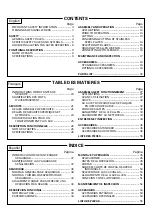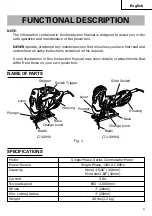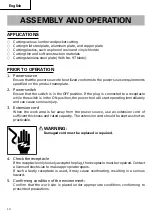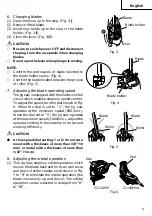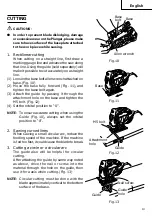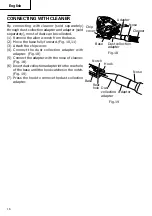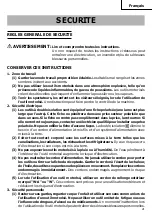
7
English
15. Operate power tools at the rated voltage.
Operate the power tool at voltages specified on its nameplate.
If using the power tool at a higher voltage than the rated voltage, it will result in
abnormally fast motor revolution and may damage the unit and the motor may burn
out.
16. NEVER use a tool which is defective or operating abnormally.
If the tool appears to be operating unusually, making strange noises, or otherwise
appears defective, stop using it immediately and arrange for repairs by a Hitachi
authorized service center.
17. NEVER leave tool running unattended. Turn power off.
Don’t leave tool until it comes to a complete stop.
18. Carefully handle power tools.
Should a power tool be dropped or struck against hard materials inadvertently, it may
be deformed, cracked, or damaged.
19. Do not wipe plastic parts with solvent.
Solvents such as gasoline, thinner benzine, carbon tetrachloride, and alcohol may
damage and crack plastic parts. Do not wipe them with such solvents.
Wipe plastic parts with a soft cloth lightly dampened with soapy water and dry
thoroughly.
20. ALWAYS
wear eye protection that meets the requirement of the latest revision of ANSI
Standard Z87.1.
21. ALWAYS
be careful with buried object such as an underground wiring.
Touching these active wiring or electric cable with this tool, you may receive an electric
shock.
Confirm if there are any buried object such as electric cable within the wall, floor or
ceiling where you are going to operate here after.
22.
This Jig Saw employs a high-power motor. If the machine is used continuously at low
speed, an extra load is appplied to the motor which can result in motor seizure. Always
operate the power tool so that the blade is not caught by the workpiece during operation.
Always adjust the blade speed to enable smooth cutting.
23. Definitions for symbols used on this tool
V ............ volts
Hz .......... hertz
A ............ amperes
n
o
.......... no load speed
W ........... watt
.......... Class
II
Construction
---/min ... revolutions or reciprocation per minute
.......... Alternating current


